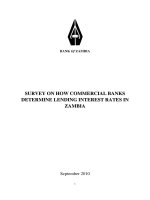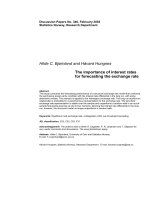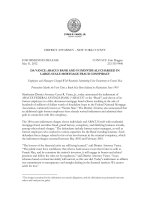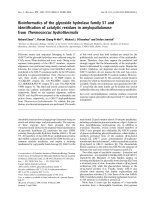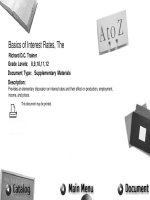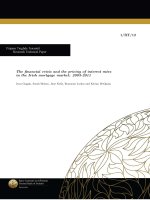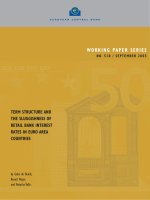The financial crisis and the pricing of interest rates in the Irish mortgage market: 2003-2011 ppt
Bạn đang xem bản rút gọn của tài liệu. Xem và tải ngay bản đầy đủ của tài liệu tại đây (691.6 KB, 40 trang )
1/RT/12
The financial crisis and the pricing of interest rates
in the Irish mortgage market: 2003-2011
Jean Goggin, Sarah Holton, Jane Kelly, Reamonn Lydon and Kieran McQuinn
The financial crisis and the pricing of interest rates in the Irish
mortgage market: 2003-2011
Jean Goggin, Sarah Holton, Jane Kelly, Reamonn Lydon and Kieran McQuinn
Abstract
This paper examines the changing manner in which Irish financial institutions set their variable
interest rates over the period 2003 - 2011. In particular, the onset of the financial crisis clearly
results in a break in the pass -through relationship between market rates and variable rates at the
end of 2008 in the Irish mortgage market. Until the end of 2008 variable rates for all lenders closely
followed changes in the ECB’s policy rates, short-term wholesale rates and tracker rate mortgages.
Thereafter, the relationship breaks down, in part due to banks’ increased market funding costs. It
appears that some lenders with higher mortgage arrears rates and a greater proportion of tracker rate
loans on their books exhibit higher variable rates. After controlling for these factors and additional
funding costs, most of the divergence between banks’ variable rates is explained, but there are some
exceptions. There is also some evidence of asymmetric adjustment in rate setting behaviour: that
is, rates tend to adjust slowly when they are above the long-run predicted level but more quickly
when they are below this level. This asymmetric adjustment behaviour appears to increase in the
post-2008 period.
2
Non Technical Summary
Over the period 2003 - 2011 there are two clear regimes indentifiable in the relationship between
policy rates and the variable rates offered by Irish financial institutions. Up to 2008, standard
variable rates in the Irish mortgage market closely followed policy rates, and consequently tracker
rate mortgages. From 2008 onwards and mainly for reasons attributable to the financial crisis, the
interest rates on variable and tracker rate mortgages have diverged. This paper seeks to explain
movements in Irish variable mortgage interest rates and to examine the factors which affect the
changing relationship between market rates and bank lending rates over this period.
We analyse descriptive statistics of variable rate mortgages, which account for around half of
outstanding loans and a third of outstanding balances. We then examine the pass-through relation-
ship between variable rate mortgages and banks’ funding costs and structure, along with market
rates and characteristics, by drawing data from several different sources. While variable rates for
all lenders did closely follow changes in policy rates, short-term wholesale rates and tracker rate
mortgages, we find a structural break in the relationship towards the end of 2008, which confirms
our prior that the relationship has changed. Therefore, we model the relationship both before and
after the break. We also examine for asymmetric behaviour in interest rate changes and include
alternative measures of funding costs which faced the banks in the post 2008 period.
The results of this analysis show that pass-through varied little across banks before the break in
2008 and that changes in money market and deposit rates are an important determinant for standard
variable rates. In the post 2008 period, the breakdown in pass-through between lending rates and
monetary policy and money market rates is partly explained by increased market funding costs,
captured by direct fees and indirect market spreads. Also, as we expected, some lenders with higher
mortgage arrears rates and a greater proportion of tracker rate loans on their books exhibit higher
variable rates. Competitive pressures also impact on lenders’ variable rates, particularly before the
end of 2008. There is also evidence that when variable mortgage rates are below the level suggested
by the prevailing environment, that they adjust more quickly than when they are above, particularly
after 2008.
1 Introduction
The international financial crisis has had a profound impact on the key determinants of variable
interest rates charged in the Irish mortgage market. Up to 2009, standard variable rates in the
Irish mortgage market closely followed policy rates. Thereafter, this relationship appears to have
broken down. Accordingly, this paper seeks to explain movements in variable rate mortgage interest
rates and examine the factors which affect the changing relationship between market rates and bank
lending rates over the period 2003 - 2011.
In the run up to the financial crisis, Irish credit institutions built up a heavy reliance on short-
term wholesale financing as they rapidly expanded their balance sheets. The resulting gap between
loans and deposits (ratio of around 1.8 at end 2010) left these institutions highly susceptible to the
general downturn in international market confidence from 2008 onwards. Consequently, the Irish
financial system began to experience significant funding outflows, a shortening of maturities and an
increased reliance on central bank sources to make up part of the shortfall.
1
Most of the lending by Irish institutions was heavily concentrated in the residential and commer-
cial property markets. Across the OECD over the period 1995 to 2007, Irish house price increases,
at 9 per cent per annum, were the largest. While initially much of the boom in Irish house prices
is generally regarded to have been determined by improvements in fundamental economic factors
such as increased income levels, lower unemployment and stable interest rates, the availability of
wholesale funding post 2003, significantly increased the supply of credit to the residential market.
The existing boom in both the residential and commercial property markets at this time r esulted
in significant demand for this increased source of funding amongst credit institutions. By 2007 a
growing body of opinion was of the view that Irish house prices were considerably overvalued
2
- this,
compounded by the onset of the financial crisis internationally, left Irish institutions particularly
exposed to funding vulnerabilities.
In general the interest rate pricing behaviour of financial institutions can be considered within
a marginal cost pricing model, where a mark up is used over money market rates. Market rates
are typically viewed as the most accurate reflection of the marginal funding costs faced by banks,
and the mark up is used to capture oper ational costs and risk associated with lending. Perfect
pass-through from market rates to retail rates is not expected due to information asymmetries and
1
Measures are in place to reduce the Irish banking system to a manageable size and to stabilise
its funding base - see FMP for details ( />institutions/Documents/The %20Financial%20Measures%20Programme%20Report.p df).
2
See Honohan (2007) for more on this.
4
imperfect competition, however, in a more stable market environment the rates charged by banks
tend to closely follow changes in money market rates.
Prior to the crisis, Irish banks accessed short term wholesale funding at levels close to euro
area benchmark money market rates and this heavily influenced their marginal cost of funds. With
the onset of the crisis, and Irish banks finding it increasingly difficult to raise wholesale funds,
particularly term maturities, these institutions had to pay increased premiums relative to euro area
benchmarks. Central bank funding offset the cost to some extent but the marginal cost of funds,
arguably, was no longer heavily influenced by wholesale rates - corporate and wholesale type funding
fell from roughly two-thirds to one-third between end 2008 and 2010. This development is likely to
have had a significant impact on variable rate pricing in the Irish market.
Loans in the Ir ish mortgage market, are issued either on a fixed or variable rate, with the
vast majority (85 per cent) on the latter. There are two typ es of variable rate loans: those that
track the ECB base rate at an agreed margin, typically called ‘trackers’, and those that do not. In
the case of the latter, the lender offers no specific link to an underlying market or wholesale rate
and can choose to increase or decrease the rate at its discretion. In this paper, when we refer to
variable rate mortgages, we mean excluding trackers. The most common variable rate product is the
Standard Variable Rate or ‘SVR’. Lenders stopped offering tracker rate mortgages in 2009, when
the underlying profitability risk inherent in such products was starkly exposed by the divergence of
funding costs from the policy rate or interbank lending rates, such as the Euro Interbank Offer Rate,
known as Euribor. In the last two years, the majority of new mortgages have been on a variable
rates.
This paper , using a panel data approach, seeks to explain movements in Irish variable rates
over the period 2003 - 2011. In particular, the paper assesses the implications of the international
financial crisis on the funding costs of Irish institutions. The approach also takes into account
the implications of the continued deterioration in the performance of the Irish mortgage market -
especially, the significant increase in arrears experienced by all lenders from 2007 onwards. In this
context, we specifically examine why some Irish lenders increased variable rates more than others.
Various policy measures such as the introduction of a government guarantee scheme for deposits as
well as the cost of the liquidity funding provided by the ECB and the Irish central bank are also
incorporated within the analysis.
The rest of the paper is outlined as follows: Section 2 provides further information on variable
rates in the context of the overall Irish mortgage market; section 3 summarises the literature on
interest rate pass through; section 4 presents the results from the empirical analysis while a financial
section concludes.
5
2 Variable rates and the Irish Mortgage Market in context
2.1 Share of balances, average balances and interest rates
In Figure 1 the average tracker and variable rate for the Irish mortgage market is plotted in the
left-hand side panel. The average difference between variable rates across the Ir ish market, shown in
the right-hand side of Figure 1, is currently 2 per cent. Figure 2 shows the share of current mortgage
balances in the Irish market accounted for by variable, tracker and fixed rate loans. In both the
owner-occupier and buy-to-let segments, variable rate mortgages account for around one-third of
balances. The average balance on variable rate loans is considerably lower than tracker and fixed
rate loans. Therefore, the share of loans (and households) that are on variable rates is higher and
closer to a half.
Table 1 shows the average mortgage loan balances and interest rate by loan type for the four
Financial Measures Programme institutions.
3
The data give a sense of both the prevalence of variable
rates in the Irish mortgage market, and the difference in average interest rates when compared with
other interest rate types. For owner-occupiers, the average balances at end 2010 for variable, tracker
and fixed r ate mortgages were around e85,000, e165,000 and e145,000 respectively. The main
reason for the difference in balances is that the majority of loans originating during the recent
housing boom were tracker loans; whereas older vintage loans, with both smaller originating and
current balances, tended to be variable rate loans (see Figure 4). A final point worth noting is that a
large number of fixed-rate loans that are shown in the right-hand side of Figure 3, are due to revert
to variable rate loans in the next few years.
2.2 Mortgage distress and interest rate type
Falling incomes and rising unemployment in recent years have left many borrowers struggling to
service outstanding mortgage debt. Figures from the Central Bank of Ireland (2011) for the end of
September 2011 show 8.1 percent of private residential mortgage accounts in arrears for 90 days or
more, accounting for e12.4 billion or 10.8 percent of outstanding balances. If we include those loans
that have had some form of restructuring plus loans in arrears of less than 90 days, almost one in
five mortgage holders are facing, or have faced, some form of difficulty meeting their repayments.
Lydon and McCarthy (2011) use loan-level data to examine the determinants of mortgage arrears.
However, the interest rate on the loan in this analysis only enters indirectly via the mortgage payment
to income ratio. In this section, we examine whether variable rate customers have fared better or
3
AIB, Bank of Ireland, EBS and PTSB.
6
worse than their tracker or fixed rate counterparts, and if so, what is the reason for the difference.
Figure 5 shows the Capital Requirements Directive (CRD) default rate for the four Financial
Measures Programme institutions by interest rate type.
4
The arrears rate for variable rate customers
is 3 to 4 percentage points higher than the rate for tracker customers. An important question is
whether the higher arrears rate we observe for variable rate loans is because they attract significantly
higher interest rates, or for other reasons that might make them more likely to be in arrears, e.g.
other borrower, lender or loan characteristics. Table 2 shows the results from a probit regression
where the dependent variable is equal to one if a loan is 90-plus days past due and zero otherwise.
The results indicate that even after controlling for a range of factors, the arrears rate for variable
rate loans is significantly higher than both tracker (2 percentage points higher) and fixed rate (4
percentage points higher) loans.
Table 3 summarises the results from another probit regression, including the actual interest rate
directly as a control. The first column (model 1) shows the bivariate regression and reaffirms the
pattern shown in Figure 5: the arrears rate is 2 percentage points higher for variable rate mortgages,
compared with tracker rate mortgages. The second model adds a control for the log of the interest
rate, which is positive and highly significant. The inclusion of the interest rate variable reverses
the sign on the variable rate dummy variable, which is now negative and signficant. The third and
fourth columns add additional controls incrementally, such as income, LTV and other loans. The
results from the regression analysis indicate that the higher arrears rate for variable loans is not
explained by the observable characteristics of the borrower and indicate that higher interest rates
to some extent may explain arrears.
2.3 Bank funding costs and interest margins
This section provides some background on two other potential drivers of variable rates: banks’
interest margins and funding costs. The net interest margins for Irish institutions have declined for
the last two decades, as shown in the bottom of Figure 6. The average net interest margin for the
2005 to 2008 period is 1.6 per cent. As discussed in the empirical analysis, we obtain similar margins
over Euribor for the period up to the end of 2008. According to European Banking Authority (EBA)
stress test figures for December 2010, Irish banks’ net interest margins were at the lower end of the
range (see Figure 6, top panel).
4
The CRD introduces a supervisory framework for capital measurement and adequacy standards in the
financial services industry that reflects the Basel II rules.
7
Prior to the onset of the banking crisis, Irish banks accessed short term wholesale funding at
rates close to European benchmarks such as Euribor. An ECB survey confirmed that variable rate
pricing was largely based off the ECB main refinancing rate or 3-month Euribor for Irish lenders
in 2007 (ECB Occasional Paper, 2009). This explains why variable rates followed tracker rates
so closely up to the end of 2008. Market funding costs have risen substantially since the onset
of the crisis. Domestic banks have experienced significant funding outflows of corporate deposits
and wholesale debt securities (Figure 7, left panel). Given Irish lenders’ high loan to deposit ratios
relative to many European peers, there has also been an increased reliance on central bank funding
as a means of partially offseting these outflows (Figure 7, right panel).
Borrowing from the Eurosystem peaked at 21.3 per cent of total liabilities in January 2011,
before falling back to 17 per cent by end-2011.
5
Remaining liabilities, which include the Emergency
Liquidity Assistance (ELA) provided by the Central Bank of Ireland, accounted for just over 10 per
cent of total liabilities in July 2010 but rose rapidly from this point. Its contribution peaked in
March 2011, at 23 per cent of total liabilities.
6
Banks also pay a fee to the government for the Eligible Liabilities Guarantee (ELG), which
covers deposits, certificates of deposit, commercial paper, senior unsecured bonds and notes and
other senior debt.
7
The covered banks have paid fees to date of e1.8 billion for the scheme. The
quantity of assets guaranteed by the state has fallen from a peak of e375 billion in Q3 2008 (under
the pr evious broader scope scheme) to e100 billion in Q3 2011, reflecting the funding outflows and
shortened maturity profile experienced by the covered institutions. Nonetheless, given the increasing
5
These shares and the series shown in Figure 7 are based on statistical balance sheet data, which pr ovide
details of the liabilities of within-the-state offices or branches of the Irish-owned institutions, including IBRC.
The data are unconsolidated, however for the purpose of this analysis they have been adjusted to exclude
dep osits from resident and foreign affiliated MFIs.
6
The ECB provides system wide liquidity to euro area eligible credit institutions through standard oper-
ations against a clearly defined range of collateral assets. T he ECB bears the risk of these loans as opposed
to the national central bank (NCB) in the country where the funds are lent. By contrast, ELA is not system
wide lending - it should only be provided to a solvent bank experiencing temporary liquidity problems. ELA
is at the discretion of the NCB, subject to ECB approval, with the risk lying with the NCB. If there is any
doubt as to a bank’s solvency, a national government guarantee would be required in relation to the NCB’s
liquidity support.
7
The ELG, introduced in December 2009, provides a Government Guarantee on certain liabilities of a
number of credit institutions in Ireland and is one of a range of measures designed to stabilise confidence in
the domestic banking system. Further details on the ELG are available from the Department of Finance:
http://www.finance.gov.ie/viewdoc.asp?DocID=7071.
8
fee structure imposed by the European Commission over time to incentivise exit, the Department of
Finance estimate that the average effective ELG cost has doubled since its introduction from 50bps
to 100bps in Q3 of 2011.
There is a lack of time series data on both the price and quantity components of banks’ fund-
ing costs. However, drawing on a range of sources, we have constructed funding cost estimates for
the domestic banks as at December 2011. The calculation uses group level volume data on funds
outstanding by instrument, and makes the following assumptions as to the interest rates for each
category:
• Retail deposits - we use household share weighted deposit rates (outstanding business rates
weighted by volume per maturity category) from the resident statistical returns.
• Corporate and non-bank financial deposits - we use the matching non financial corporations’
(NFCs’) rates on outstanding business from the resident statistical returns.
• Repo and interbank funding - we use average rates paid drawn from a small sample of recent
repo deals, sourced from Central Bank of Ireland, Treasury.
• Debt issuance - we use a sample of at issue yields on bonds issued by domestic banks since
the crisis (e.g. on asset covered securities, ELG debt and senior unsecured issues).
• Official borrowing - for ECB and other central bank borrowing we apply the official rates.
• ELG fee estimates - on the basis of the guaranteed liabilities data as at end October 2011.
Table 4 shows an estimate of the price and quantity components of funding costs, as at December
2011 for the FMP institutions. The calculation uses group level volume data on funds outstanding
by instrument, and makes a number of simplifying assumptions as to the interest rates for each
funding component. For example, we assume the same interest rate applies to domestic and UK
deposits; we also assume that the rate on non-bank financial institution (NBFI) deposit rates is
equal to the rate on NFC deposits. For debt issuance, we have not adjusted rates for maturity or
other features such as options. Furthermore, from a marginal cost perspective, the yields on the
bonds selected may be biased downwards if they are drawn from pre-crisis issuance. On the basis of
these figures, we estimate average funding costs for these institutions of around 2.6 per cent. This
compares with an average standard variable mortgage rate of 3.9 per cent in December 2011. We
take account of funding costs using a number of different measures, as discussed in the empirical
approach in section 4.
9
The estimates in Table 4 should be treated as a guideline since they are subject to a number of
assumptions (see table notes) and also exclude costs relating to credit risk, oper ating costs, the costs
of holding capital and liquidity costs. Nonetheless, the estimate does inform our understanding
in a number of ways. First, it suggests that banks’ cost of funds are significantly higher than
using the December ECB base rate (1 per cent) or 3-month Euribor (1.36 per cent) alone would
suggest. Intuitively, therefore, one might expect variable rates to be higher than tracker rates, which
incorporate a typical margin of 1 to 1.3 per cent. Second, the range of cost estimates (0.65 per cent
between lowest and highest) is narrower than the range of variable mortgage rates s et by these
institutions (1.95 per cent between lowest and highest). Hence, there may be merit in checking
whether other factors, in addition to funding costs, help explain the divergence across institutions.
In the empirical section below we incorporate what panel data there is on funding costs (Euribor
and ELG fees) to test this relationship more formally.
We can also use the funding cost estimates to get a sense of how overall costs might respond to a
hypothetical change in a particular element of funding. For example, suppose we reduce the cost of
central bank funding by 0.25 per cent, while holding all other funding costs constant, the weighted
average cost of banks funding falls by 0.06 per cent. In practice, the impact might vary depending
on the rates banks offer on other elements of funding such as retail and corporate deposits. In other
words, whether they also cut deposit rates in response to an ECB rate cut. The quantities of funding
from each source are also likely to evolve over time. In particular, reliance on central bank funding is
not a sustainable strategy for the future even if it is cheaper at present. Furthermore, the domestic
banks are obliged to reduce their loan to deposit (LDR) ratios to 122.5 per cent by end 2013 as part
of the Financial Measures Programme to help create a clean, appropriately-sized banking system
and make market funding more attainable.
3 Pass through literature
The literature on interest rate pass-through can be categorised into two broad strands. The monetary
policy perspective examines the functioning of the monetary transmission mechanism, and analyses
the degree and speed at which the policy rates or money market rates (which are often assumed
as the closest proxy for bank funding costs) are transmitted into lending and deposit rates. The
industrial organisation (IO) perspective looks at banks’ pricing of loans and deposits in proportion to
their costs of funds. The IO framework incorporates bank characteristics, such as financial structure,
and market features, such as competition, in the pass-through framework.
In a perfectly competitive financial system, banks set their retail rates equal to marginal costs
10
and any change in the marginal cost is passed on in its entirety to retail rates. However, a more
likely depiction of marginal cost pricing model is that outlined by Rousseas (1985), whereby retail
lending rates (r) are based on the cost of funds (mr) plus a mark-up (α
0
), called an “interest rate
spread” from which they make a profit:
r
t
= α
0
+ β
1
mr
t
+ β
2
X
t
+ ǫ
t
. (1)
This outlines the long run relationship between market rates and retail rates with β
1
capturing
the long run extent of pass-through. The matrix X captures other factors that may affect the
variable interest rate setting behaviour by lenders, such as balance sheet structure and competitive
pressures.
The inclusion of additional macro and micro variables in (1) usually motivated by the industrial
organisation literature, can identify what factors drive overall pass-through and explain changes
and differences in banks’ price setting behaviour. For example, pass-through may be incomplete
(β
1
=1 in equation 1) due to a higher or lower interest rate elasticity of demand, depending on the
frictions in the system. Switching costs associated with moving banks can reduce the elasticity of
borrowers’ demand (Klemperer, 1987). This factor may be particularly relevant to Ireland in the
post-2008 period, when customers’ ability to switch has been, arguably, curtailed by a combination of
rapidly rising negative equity (Kennedy and McIndoe-Calder, 2011) and tightening credit standards
(Kelly, 2011 and McCarthy and McQuinn, 2011). On the credit supply side, menu costs incurred
from interest rate adjustments (Hofmann and Mizen, 2004) and credit rationing (Stiglitz and Weiss,
1981) can obstruct pass-through and interest rate margins are affected by money market volatility
and banks’ risk aversion (Ho and Saunder, 1981).
Putkuri (Finland, 2010), Cecchin (Switzerland, 2011), Gambocorta (Italy, 2004) and De Graeve
et al. (Belgium, 2007) include factors such as banks’ costs, competition, risk, capital, structural
breaks, non-linearities (menu costs and switching costs) and asymmetric adjustment. To varying
degrees, they all find a role for all of these factors in explaining pass-through. Most of these papers
use panel data and find that pass-through can vary considerably across institutions, even after
including a range of institution specific controls.
Raknerud et al. (2011) use a dynamic factor model to analyse the effect of banks’ funding costs on
retail rates in Norway. The results point to incomplete pass-through and that, when market funding
costs increase, banks’ net interest margins decreases. However, there is considerable heterogeneity
between institutions, with those that have a large share of market financing more vulnerable to
increases in the market rate. In an Irish context, Bredin et al. (2001) find evidence of incomplete
11
pass-through for lending rates, with a pass through coefficient of between 0.5-0.6).
4 Modelling variable mortgage rates
This section pres ents the results from an empirical analysis of interest rate pass-through for five
lenders: Allied Irish Banks, Bank of Ireland, Educational Building Society, Permanent tsb and ICS
Building Society. We first summarise the data used in the analysis; next, we present the results from
a structural break analysis which tests for a break-down in the relationship between the variable
rates and Euribor after 2008; finally, we look in more detail at the determinants of the variable
interest rates in the post-2008 period.
4.1 Data
Table 5 summarises the data used in the modelling. The price lenders have to pay for their funding
is a key variable of interest in the analysis. In the case of Ireland up to the end of 2008, lenders
tended to use the ECB base rate or three-month Euribor as a benchmark for adjusting the pricing of
variable rate mortgage. However, as the financial crisis deepened and uncertainty in money markets
rose, Irish banks’ access to the interbank market became very restricted, which would imply that
money market prices no longer remained a very relevant measure to these banks. Two key factors
that are likely to be driving the cost of funds in recent years are increases in deposit rates and the
costs attributed to the ELG.
4.2 Structural break tests
In the first instance we test for a breakdown in the relationship between the variable rate and
Euribor in or around the end of 2008. Table 6 shows the detailed results from bank-by-bank Bai-
Perron structural break tests. The results, which are illustrated in Figure 8, confirm our prior that
the long-run relationship broke down some time after the end of 2008. Based on this result, the
econometric models of interest rate pass through are estimated separately for the period up to the
end of 2008, and thereafter.
12
4.3 Error correction models
4.4 Variable rates up to 2008
Building on the existing literature on the determination of variable retail interest rates, we estimate
a panel error correction model specified as follows:
△r
i,t
= λ(r
i,t−1
− α
0
− β
1
E
t−1
− β
2
X
t−1
) +
4
j=1
θ
j
△ r
i,t−j
+
4
j=0
η
j
△ E
t−j
+
4
j=0
γ
j
△ X
t−j
+ ψ
1
D
1
+ ψ
2
D
2
+ µ
t
. (2)
Where E
t
is the three-month Euribor rate and X is a (K x N) matrix of other explanatory factors,
such as deposit rates, loan to deposit ratios, a Herfindahl index to measure market concentration,
bank bond yields, money market spreads and additional fees. Some of the additional explanatory
variables come to the fore in the post-2008 period where the relationship between variable rates and
Euribor breaks down. The D
1
and D
2
variables are dummy variables designed to pick-up asymmetric
adjustments in the deviations from the long-run relationship between the variable rate and Euribor
and are defined as follows:
D
1
= 1 iff (r
i,t−1
− α
0
− β
1
E
t−1
− β
2
X
t−1
) > C
+
, (= 0 otherwise)
D
2
= 1 iff (r
i,t−1
− α
0
− β
1
E
t−1
− β
2
X
t−1
) < C
−
, (= 0 otherwise)
We impose a value of +/-7.5 per cent for the threshold values C
+
and C
−
. These values capture
the adjustment costs associated with a rate change. They are particular to the Irish data and are
selected to fit past behaviour of interest rate changes.
8
Of particular interest in the analysis will
be whether the coefficients on these asymmetric-adjustment terms change significantly pre- and
post-2008.
In the model β
1
is set equal to 0.61 for all banks, based on the results from an FM-OLS group
estimate, the results of which are shown in the Table 6. This measure captures the typical pass-
through rate that prevailed across banks and building societies until 2008Q4. The results from
estimating the long-run and short-run regessions for equation 2 until the end of 2008 are shown
8
Previous studies also select the thresholds to suit past behaviour of interest rates in their dataset. For
instance, Sander and Kleimeier (2004) and and De Graeve et al. (2007) select the threshold that minimises
the residual sum of squares or results in the maximum likelihood model.
13
in Table 7 and 8 respectively. The additional explanatory variables included in the regression are
deposit rates and a measure of degree of competition in the market, the Herfindahl concentration
index (HHI) shown in the right-hand side of Figure 9.
The coefficients all have the expected sign, and the long-run relationship between the variable
rate and Euribor is confirmed in this model. As expected, increases in the deposit rate - one potential
source of funding - increases the variable rate. We also observe strong competition effects, that is,
the higher the level of concentration in the market, as measured by HHI, the higher the mortgage
interest rate, controlling (as we do) for funding costs. None of the bank fixed-effects are significantly
different from one-another in the long-run regression, and the fixed effects imply a mark-up of around
1.6 percentage points.
9
The results from the long-run model are largely confirmed by the Panel ECM, although the HHI
is no longer significant in the latter, and we, therefore, drop it from the estimation. For comparison
with the post-2008 period, the coefficients on the asymmetric adjustment terms (ψ
1
and ψ
2
) are of
particular interest. We find that when variable rates are above the level indicated by the long-run
relationship with Euribor, the adjustment downwards is slower (ψ
1
>0). Conversely, when variable
rates are below the level indicated by the long-run relationship with Euribor, the adjustment upwards
is faster (ψ
1
<0). This is a noteworthy result, particularly if one accepts that we have controlled
adequately for funding costs, as it indicates some degree of pricing power on the part of lenders.
However, the coefficients are not significantly different from one-another in absolute terms.
4.5 Variable rates post-2008
This section explores the reasons for the growing spread between the short-term interbank rates
(Euribor) and variable rates in the post-2008 period. We add explanatory variables to the previous
panel ECM, as suggested by the literature and the previous discussion on the domestic banks funding
difficulties. The results from the long-run regression for the post-2008 period are shown in Table 9.
The results from the panel ECM model are shown in Table 10.
We report the long-run res ults, both with and without the fixed effects (Table 9). The reason
for this is that for the shorter time period certain variables of interest with little time variation, but
some cross sectional variation can be correlated with the fixed effects. The main variable, which
interacts with the fixed effects is the share of loan balances that are tracker and it is, therefore,
excluded from the panel specification (columns 3 and 4, Table 9). In the specification without fixed
effects (columns 1 and 2, Table 9) we find that some lenders with higher shares of tracker loans on
9
This figure was obtained by running the regression in levels not logs (not shown).
14
their books have higher variable rates. This is intuitive if tracker loans are loss-making and profit
opportunities exist in the variable rate segment. We do not find HHI to be significant in the second
specification, although competition factors could be picked up indirectly by other controls, such as
lenders’ ability to profitably impose higher rates on variable rate customers.
In the post-2008 period, the pass-through rate from Euribor to variable rates falls to less than
0.30 per cent, consistent with the structural break tests. The post-2008 model includes ELG fees and
the spread between the 3 month Euribor and the Euro Overnight Index average, or Eonia, which
is the average rate that banks lend to each other overnight. The Euribor-Eonia spread captures
financial market uncertainty and risk, which increases funding costs for banks. Figure 11 shows the
development of this spread and the increases during times of high uncertainty. Both the ELG fee
and the Euribor-Eonia spread capture increased funding costs over and above Euribor, and they are
both positively correlated with variable rates. A word of caution in interpreting the actual size of
the ELG fee coefficient, which at first glance appears small: the ELG fee is zero prior to 2010, and it
is only after this point that it begins to increase significantly, hence the relatively small coefficient.
We include the arrears rate in the regression to control for additional credit risk costs. We find
it is positively correlated with the variable rate. This result probably captures the fact that the
higher levels of arrears are causing greater losses for banks and, so, institutions may try to generate
more revenue from performing loans to compensate for these losses. This hypothesis is consistent
with the view that a higher arrears rate is a driver of interest rate spreads. It is very possible that
causality also runs in the opposite direction, with higher interest rates pushing home owners into
arrears, as suggested in the analysis in Section 2.2.
Table 11 presents the results from a set of Granger causality tests, providing strong evidence that
higher arrears do cause higher interest rates. While these results justify our inclusion of arrears as an
explanatory variable for interest rates, they do not exclude the possibility that causality is bilateral.
Further evidence is provided in Figure 10, which shows a cross-plot of the standard variable rate
against the arrears rate for the 2009 to 2011 period. A cross-plot of variable rates and arrears for
the earlier period up to the end of 2008 would actually show a similar pattern. However, when we
include arrears in the long-run regression for the earlier period we find that it is insignificant, after
controlling for direct measures of funding costs.
The general-to-specific modelling approach means that we tried a number of other variables in
the sepcification, such as the swap curve and the spread between Euribor and the G erman treasury
bill (TED Spread) that were not significant in the final specification. We also included Merrill Lynch
bank bond indices to try to capture the more expensive term debt story but they were found to be
insignificant. It may be that Irish banks were more or less locked out of term markets over that time.
15
We also tested for a relationship between loan-to-deposit ratios and variable rates, the hypothesis
being that those banks with higher ratios will increase rates more. We observe a positive and
significant relationship between variable rates and loan-to-deposit ratios in a bivariate specification.
However, the inclusion of additional controls such as the arrears rate and ELG fees in the multivariate
setting makes it insignificant and we, therefore, exclude it from the final specification.
We find positive and significant bank fixed effects in the period after the end of 2008, with mark-
ups in the range of 1.42 per cent to 1.7 per cent. The inclusion of the arrears and the tracker rate in
the second period picks up a significant amount of cross-sectional variation. When it is excluded, the
average mark-up is 2.8 per cent. As before, the fixed mark-ups are all jointly significant (F=71.8,
p-value=0.000). However, in contrast to the earlier period, we find that the fixed mark-up of one
bank (E) is significantly higher than its peers, while for one other bank (A) it is significantly lower,
even after controlling for funding costs and profit pressures.
With the exception of the ELG fee and Eonia spread, which we find to be consistently reliable
predictors of the variable rate in the post-2008 period, the panel specification is almost identical to
that for the earlier period. Relative to the earlier period, and in absolute terms, both asymmetric
adjustment variables have increased. This means that, relative to the period up to the end of 2008,
lenders are slower to reduce rates when they are above the long-run level implied by funding costs,
but quicker to increase rates when they are below the long-run level. This could be a reflection of
lenders’ increasing pricing power in this period. Furthermore, the error correction term has increased
in absolute value, indicating that lenders are perhaps more sensitive to the funding cost pressures
implied by the long-run relationship.
5 Conclusion
This paper has assessed the implications of the financial crisis on the pass-through relationship
between policy and market variable rates. The crisis has had a particularly acute impact on the
Irish banking sector. Given its substantial reliance on international wholesale funding and the heavily
concentrated nature of its lending, the Irish financial system was effectively confronted by a “per fect
storm” in 2008 with a litany of adverse consequences.
We find that before the end of 2008 variable rates are explained by three factors: funding costs,
a mark-up over funding costs and competitive pressures. The two measures of funding costs that
best explain variable rates in this period are deposit rates and the Euribor rate, with a pass-through
rate of approximately 0.6. There is no particular reason to expect a one-to-one pass through from
the Euribor rate to variable interest rates, as a variety of factors such as operating costs, credit
16
risk, menu costs and other longer-term funding costs not directly captured in our model could also
determine rates. To an extent, some of these factors will be captured by the individual effects in
our model. One of the key findings from the analysis of variable rates up to the end of 2008 is that
while these individual bank effects are jointly significant, they are not significantly different from
one-another.
The main reason variable rates diverge from tracker rates after 2008 is that banks’ funding
costs and related pressure on variable rates are no longer captured by Euribor, whereas tracker
rates continue to follow policy rates and the Euribor rate. For example, we find that crisis-related
measures of funding costs, such as the ELG fee and Eonia spreads, are positively correlated with
variable rates and, in the case of the ELG fee, can account for approximately a sixth of funding
costs. As a rough guideline, we estimate average funding costs, including ELG fees, at 2.6 percent
in December 2011. This compares with an average standard variable mortgage rate of around 3.9
percent in December. However, this estimate excludes a margin relating to credit risk, operating
costs, the costs of holding capital and liquidity costs.
The analysis suggests costs relating to increased credit risk may be becoming an increasingly
important factor in setting variable rates. Banks with higher arrears rates tend to exhibit higher
variable mortgage rates. The second result from our analysis is that it appears that some lenders
are charging higher variables rates to compensate for the losses they are making on their tracker
loans, controlling for our estimates of funding costs. A risk with such a strategy is that it may be
counter-productive and continue to exert upward pressure on arrears. We find that after controlling
for these additional factors, most of the divergence between banks SVRs is explained.
17
References
[1] Bredin, D., T. Fitzpatrick and G. O’Reilly, 2001, Retail interest rate pass-through: the Irish
experience, Central Bank of Ireland Technical Paper 06/RT/01, November.
[2] Cecchin I., 2011, Mortgage rate pass-through in Switzerland, Swiss National Bank Working
Paper Series, 2011/08.
[3] De Graeve, F., O. De Jonghe and R. Vander Vennet, 2007, Competition, transmission and
bank pricing policies: Evidence from Belgian loan and deposit markets, Journal of Banking and
Finance, 31, 259-278.
[4] Eurosystem Monetary Policy Commitee Task Force, March 2009, Housing Finance in the Euro
Area, ECB Occasional Paper Series No. 101.
[5] Gambacorta, L., 2004, How do banks set interest rates? NBER Working Paper Series No. 10295.
[6] Goggin, J., S. Holton, J. Kelly, R. Lydon and K. McQuinn, Variable Rates in the Irish Mortgage
Market, Central Bank of Ireland Research Technical Paper Series, Forthcoming.
[7] Ho., T.S.Y. and A. Saunders, 1981, The determinants of bank interest margins: Theory and
empirical evidence, Journal of Financail and Quantitative Analysis, 16(4) November.
[8] Hofmann, B. and P. Mizen, 2004, Interest rate pass-through and monetary transmission: Evi-
dence from individual financial institutions’ retail rates, Economica 71, 99-123.
[9] Kelly, R., Y. McCarthy and K. McQuinn, Impairment and Negative Equity in the I rish Mortgage
Market, Central Bank of Ireland Research Technical Paper, 09/RT/11
[10] Kennedy G. and T. McIndoe Calder, 2011, The Irish Mortgage Market: Stylised Facts, Negative
Equity and Arrears, Central Bank of Ireland Research Technical Paper, 12/RT/11
[11] Klemperer, P., 1987, Markets With Consumer Switching Costs, Quarterly Journal of Economics,
102(2), May 1987
[12] McQuinn, K, Smyth, D. and G. O’Reill (2009), Supply response in an uncertain market: As-
sessing future implications for activity levels in the Irish housing sector, European Journal of
Housing Policy, Vol 9(3), pp.259-283.
[13] Pautkuri, H., 2010, Housing loan rate margins in Finland, Bank of Finland Research Discussion
Papers 10/2010.
[14] Raknerud, A., B.H. Vatne and K. Rakkestad, 2011, How do banks funding costs affect interest
margins? Norges Bank Working Paper, 2011/09.
18
[15] Rousseas, S., 1985, A markup theory of bank loan rates, Journal of Post Keynesian Economics,
8(1).
[16] Stiglitz J.E. and A. Weiss 1981, Credit Rationing in Markets with Imperfect Information, The
American Economic Review, 71(3), 393-410.
19
6 Appendix
Figure 1: Trends in variable mortgae interest rates
Source: Central Bank of Ireland(LHS)
www.nca.ie, www.permanenttsb.ie December 2011 (RHS)
Notes: Rates are simple averages across institutions (LHS), Variable rate for new loan of
e150,000, LTV 75%, 25 years. Variable rates for existing loans may be different, see for example
ab outmoney.com/showthread.php?t=159108 (RHS)
20
Figure 2: Interest rate type and share of balances
Source: Central Bank of Ireland, September 2011
21
Figure 3: Average interest rate by mortgage type and average balances
Source: Central Bank of Ireland, loan-level data December 2010
22
Figure 4: Current interest rate type by year of origination
Source: Central Bank of Ireland, loan-level data December 2010
23
Figure 5: Mortgage distress and interest rate type
Source: Central Bank of Ireland, QFSR
24
Figure 6: Irish Lenders’ net interest margins
Source: EBA stress tests, December 2010 (top), Central Bank of Ireland (bottom)
Note: Break in series from 2005 onwards (bottom)
25

